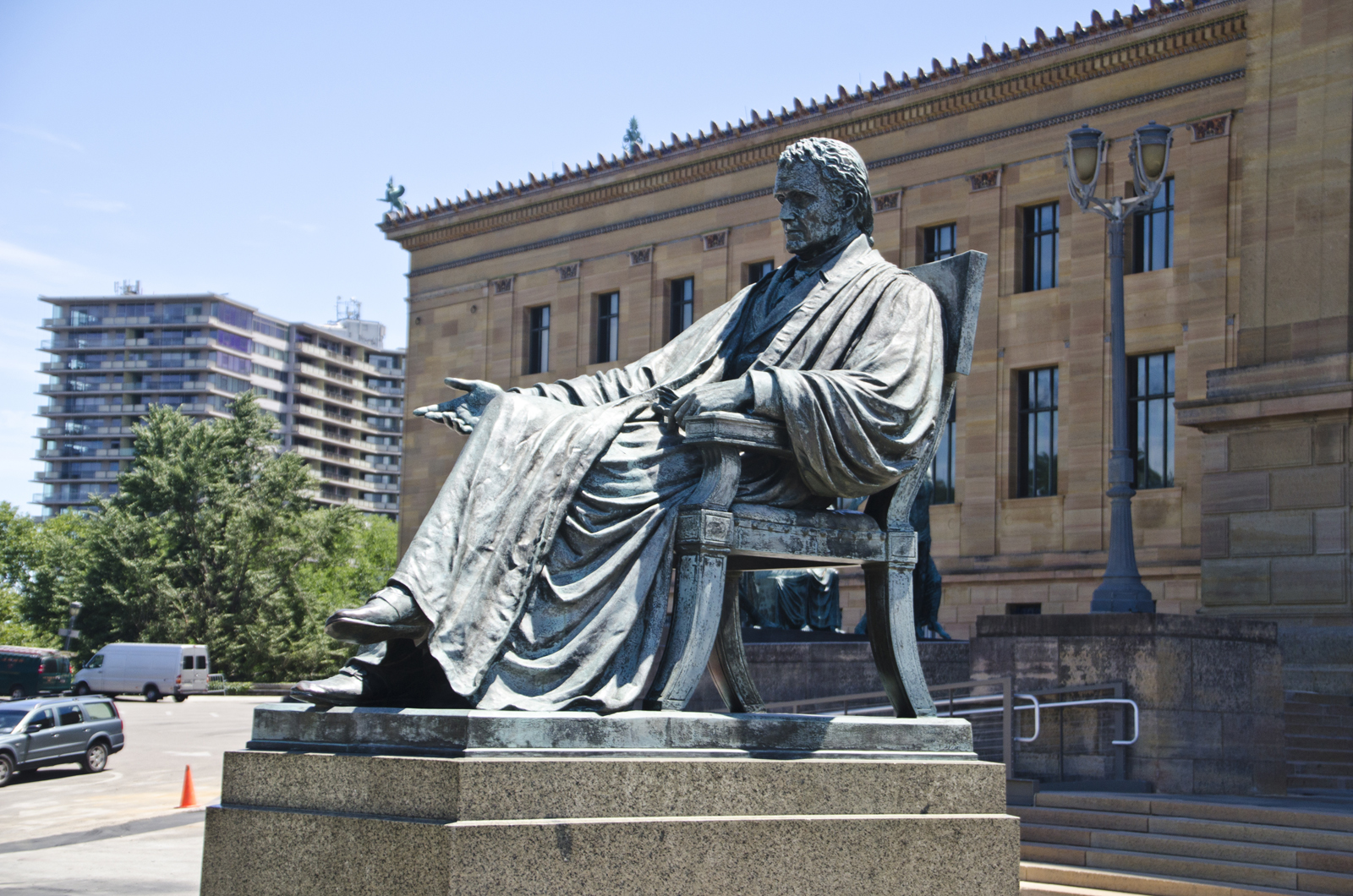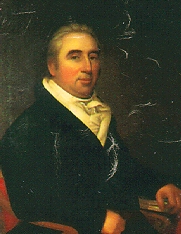Plaque on the Wall of the Supreme Court Building
Topics on the Page
John Marshall and the Supreme Court
Important Cases of the Marshall Court
- Marbury v. Madison
- Cohens v. Virginia
- McCulloch v. Maryland
- Gibbons v. Ogden
Cases Involving Native Americans
- Worcester v. Georgia
- Cherokee Nation v. State of Georgia
Famous Supreme Court Dissents
History of Women Lawyers and Judges
![]() Cross-Link: Enumerated and Implied Powers in the Constitution
Cross-Link: Enumerated and Implied Powers in the Constitution
 Cross-Link: John Marshall and the Principle of Judicial Review
Cross-Link: John Marshall and the Principle of Judicial Review
Focus Question: What made Supreme Court Justice John Marshall and the Marbury v. Madison case so important?
Supreme Court interactive historical timeline
John Marshall and the Supreme Court

 John Marshall was born in Fauquier, Virginia. He was not born to a rich family and received little formal education. He fought in the American Revolutionary War and studied law briefly from1779–80 before setting up a practice and getting elected to the Virginia legislature in 1782.
John Marshall was born in Fauquier, Virginia. He was not born to a rich family and received little formal education. He fought in the American Revolutionary War and studied law briefly from1779–80 before setting up a practice and getting elected to the Virginia legislature in 1782.
That same year he married Mary Willis Amber after a brief courtship.
Marshall was an advocate of the Federalists' position on the need for a strong centralized government, one that was supreme over the states. In 1795, he was asked by President George Washington to become the US Attorney General, but he declined because of his financial problems. As a Virginian Federalist, he was elected to the House of Representatives in 1800, but left when President John Adams appointed him chief justice of the US Supreme Court (1801–35).[1]
During his 34 years on the court, the ‘Marshall court’ profoundly shaped the law and government of the US by testing and defining the powers of the newly adopted US Constitution. Marshall made the Supreme Court a place of honor, for prior to Marshall’s appointment, most judges worked to be on the state supreme court.[2]
For a two-part essay series by a University of Chicago Law student detailing John Marshall's interactions with the institution of slavery, click here.
Perhaps his most important decision (although he had many) was Marbury v. Madison in 1803, in which he laid down the notion of ‘judicial review’
- Judicial Review holds that that federal courts had the final say in deciding whether congressional legislation was constitutional. This gave the judicial branch of the federal government the final say on the constitutionality of laws passed by Congress.
- For a Crash Course video on Judicial Review with a brief overview of the Marbury v. Madison case, click here.
- In various other decisions over the years, Marshall enforced his view of a supreme federal government over the states and their legislatures, such as McCulloch v. Maryland.
- Presiding over the treason trial of Aaron Burr in 1807, he went out of his way to attack the anti-Federalist positions of President Thomas Jefferson.
- Due to this and other reasons, Marshall was often the focus of political controversy. Autocratic in his supremacy of the court, it was he who imposed the custom of issuing a single majority opinion.[3]
The Liberty Bell in Philadelphia cracked when ringing for his funeral.
John Marshall was appointed US Chief Justice in 1801 to 1835 in which he radically changed the power of this governmental position. It was said that the Judiciary Branch was failed on its purpose. Marshall help the Chief Justice position become the sole mouthpiece of the court. Most of Marshall's opinions of the constitution are what changed this branch of government. Marshall made the US Chief of Justice equal to the power of the President in the Executive Branch of government.

Statue of John Marshall located outside the Philadelphia Museum of Art
Project for Students on Marshall's Legacy
The Marbury v. Madison Case (1803)
 |
| William Marbury |
- "In Marbury v. Madison, which was decided two years after his elevation to the bench, he decided that it was the duty of the court to disregard any act of Congress, and, therefore, a fortiori any act of a legislature of one of the states, which the court thought contrary to the Federal Constitution."[5]
Marshall's Opinion in Marbury v. Madison
See also, Judiciary Act of 1789 for more on the development of judicial power
Judicial Learning Center, where they discuss the essentiality of Judicial Review in reviewing landmark civil rights cases throughout American history. This important precedent established in the Marbury v. Madison case would be the mechanism through which equal protection under the law would be granted to women, ethnic minorities, religious minorities, and others.
A quiz on the finer details of the case.
![]() Learning Plans and Teaching Resources
Learning Plans and Teaching Resources
Justice in the Classroom which is a teaching resource funded by the John Marshall foundation. It offers a free online textbook, lesson plans, instructional videos, and allows you to request a historian or lawyer from the foundation come speak in your class.
- "Marbury v. Madison: An Introduction to Judicial Review" Lesson Plan: includes a role-playing activity, primary source documents and Jeopardy questions for review (Polk, Florida)
After completing this lesson, students will be able to explain:
- the role of the Supreme Court in interpreting the Constitution
- the significance of Marbury v. Madison
- the concept of judicial review and how Marbury v. Madison solidified it
- the relationship between the Supreme Court and laws passed by Congress and state legislatures
Marbury v. Madison on PBS
Marbury v. Madison
![]()
A short History Channel video that examines the Marbury v. Madison case
Timeline of Marbury V. Madison
The Cohens v. Virginia Case (1821)
- "In Cohens v. Virginia, in spite of the contention of Thomas Jefferson and the then prevalent school of political thought that it was contrary to the Constitution for a person to bring one of the states of the United States, though only as an appellee, into a court of justice, he held that Congress could lawfully pass an act which permitted a person who was convicted in a state court, to appeal to the Supreme Court of the United States, if he alleged that the state act under which he was convicted conflicted with the Federal Constitution or with an act of Congress."[6]
The Old Supreme Court Chamber, the meeting place of the United States Supreme Court
between 1810 and 1860, located in the basement of the United States Capitol

Marshall's Opinion in Cohens v. Virginia
The McCulloch v. Maryland Case (1819)
- "In McCulloch v. Maryland, though admitting that the Federal government is one of delegated powers and cannot exercise any power not expressly given in the Constitution, he laid down the rule that Congress in the exercise of a delegated power has a wide latitude in the choice of means, not being confined in its choice of means to those which must be used if the power is to be exercised at all."[7]
- "The decision in McCulloch v. Maryland, by leaving Congress unhampered in the choice of means to execute its delegated powers, made it possible for the Federal government to accomplish the ends of its existence. "Let the end be legitimate", said Marshall in the course of its opinion, "let it be within the scope of the Constitution, and all means which are appropriate, which are plainly adapted to that end, which are not prohibited, but consist with the letter and spirit of the Constitution, are constitutional."[9]
Marshall's Opinion in McCulloch v. Maryland
The Gibbons v. Ogden Case (1824)
- "In Gibbons v. Ogden, he held that when the power to regulate interstate and foreign commerce was conferred by the Constitution on the Federal government, the word "commerce" included not only the exchange of commodities, but the means by which interstate and foreign intercourse was carried on, and therefore that Congress had the power to license vessels to carry goods and passengers between the states, and an act of one of the states making a regulation which interfered with such regulation of Congress was, pro tanto, of no effect. It will be seen that in the first two cases he established the Supreme Court as the final interpreter of the Constitution."[8]
- "If the decision in McCulloch v. Maryland gave vigor to all Federal power, the decision in Gibbons v. Ogden, by giving the Federal government control over the means by which interstate and foreign commerce is carried on, preserved the material prosperity of the country. The decision recognizes what the framers of the Constitution recognized, namely that the United States is an economic union, and that business which is national should be under national, not state, control."[10]
Marshall's Opinion in Gibbons v. Ogden
Image of John Ross from the Encyclopedia of Alabama

Cases Involving Native Americans
Worcester v. Georgia (1832)
- See also Marshall's Opinion in Worcester v. Georgia
- Click here for a lesson plan on Worcester v. Georgia
- Click here for a PDF lesson plan about Worcester v. Georgia (1 class period)
Cherokee Nation v. State of Georgia (1832)
- See also Marshall's Opinion in Cherokee Nation v. Georgia
- Click here for a lesson plan on Cherokee Nation v. State of Georgia.
- See also Marshall's Opinion in Fletcher v. Peck
Johnson & Graham's Lessee v. McIntosh (1823)
- The case disputed whether Native Americans had the right to sell their own land or whether it was owned by the United States by default.
- This issue arose because Johnson and other men purchased land in present day Illinois from the Piankashaw Indian tribe back in 1775 and believed this meant they had ownership of what they purchased. This land was eventually resold after his death, however his heirs sued those that bought it by arguing that the Natives had no right to sell it in the first place, because they did not own it.
- Johnson’s heirs ended up winning, as the court ruled that the Natives did not own the land they sold, therefore it could not be resold. This was a monumental case during Marshall’s time as court justice and showed how the country viewed native control of the land at the time. (
Case Summary by Brian Knott, April 2021 )
Justice Johnson's Concurring Opinion

Supreme Court Dissents
The Power of a Supreme Court Dissent, David Cole, The Washington Post (October 29, 2015)
Looking Back: Famous Supreme Court Dissents, from the National Constitution Center
- John Marshall Harlan's Dissent in Plessy v. Ferguson (1896)
- Oliver Wendell Holmes and the Most Famous Dissent in American History, The Atlantic (April 10, 2013)
5 Opinions from Justice Antonin Scalia That Are Worth a Read, NPR (February 13, 2016)
Women Lawyers and Judges in History
![]() Click here to read about, "Women in History: Lawyers and Judges" from the Library of Congress website
Click here to read about, "Women in History: Lawyers and Judges" from the Library of Congress website
- Discover who the first women lawyers and judges were in different countries!
- Arabella Mansfield was the first woman admitted to the bar in the United States in 1869 in Iowa.
Works Cited:
[1] (2007). John Marshall. Retrieved April 11, 2007, from U.S. Supreme Court Media Web site: http://www.oyez.org/justices/john_marshall/
[2] Dixon, R (2006). John Marshall (1755-1835). Retrieved April 11, 2007, from From Revolution to Reconstruction Web site: http://odur.let.rug.nl/~usa/B/jmarshall/marsh.htm
[3] (1803). Marbury v. Madison (1803). Retrieved April 11, 2007, from usinfo.state.gov Web site: http://usinfo.state.gov/usa/infousa/facts/democrac/9.htm
[4] (2007). John Marshall. Retrieved April 11, 2007, from ushistory.org Web site: http://www.ushistory.org/valleyforge/served/marshall.html
[5-10] http://www.nndb.com/people/979/000049832/